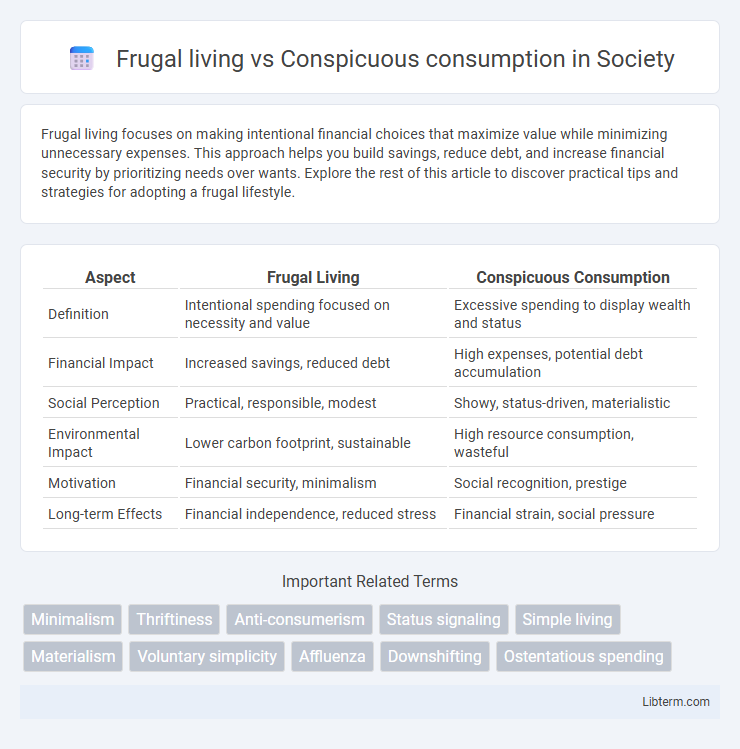Frugal living focuses on making intentional financial choices that maximize value while minimizing unnecessary expenses. This approach helps you build savings, reduce debt, and increase financial security by prioritizing needs over wants. Explore the rest of this article to discover practical tips and strategies for adopting a frugal lifestyle.
Table of Comparison
| Aspect | Frugal Living | Conspicuous Consumption |
|---|---|---|
| Definition | Intentional spending focused on necessity and value | Excessive spending to display wealth and status |
| Financial Impact | Increased savings, reduced debt | High expenses, potential debt accumulation |
| Social Perception | Practical, responsible, modest | Showy, status-driven, materialistic |
| Environmental Impact | Lower carbon footprint, sustainable | High resource consumption, wasteful |
| Motivation | Financial security, minimalism | Social recognition, prestige |
| Long-term Effects | Financial independence, reduced stress | Financial strain, social pressure |
Introduction to Frugal Living and Conspicuous Consumption
Frugal living emphasizes mindful spending, prioritizing savings and essential needs to build long-term financial security and reduce waste. Conspicuous consumption involves purchasing luxury goods and services to display wealth and social status, often driven by societal pressures and consumer culture. Understanding these contrasting behaviors reveals the impact of lifestyle choices on personal finance and social dynamics.
Core Principles of Frugal Living
Frugal living centers on mindful spending, prioritizing value and necessity over luxury, which contrasts sharply with conspicuous consumption's focus on status-driven purchases. Core principles of frugal living include budgeting meticulously, reducing waste by reusing and repairing, and making intentional choices that enhance financial security and sustainability. This lifestyle emphasizes long-term savings and resourcefulness rather than immediate gratification or social signaling through expensive goods.
Defining Conspicuous Consumption
Conspicuous consumption refers to the act of purchasing and displaying luxury goods and services primarily to showcase wealth and social status rather than for practical needs. This behavior often involves extravagant spending on non-essential items such as designer clothing, high-end cars, and lavish experiences. It contrasts sharply with frugal living, which emphasizes mindful spending, resourcefulness, and prioritizing necessities over ostentatious displays of affluence.
Psychological Drivers Behind Spending Behaviors
Frugal living is driven by intrinsic motivations such as long-term security, self-discipline, and value-based decision-making, which reduce financial stress and enhance personal satisfaction. In contrast, conspicuous consumption is strongly influenced by extrinsic factors like social status, peer comparison, and the desire for approval, often leading to impulsive and emotionally-driven purchases. Understanding these psychological drivers can help individuals recognize the underlying needs shaping their spending behaviors and make more intentional financial choices.
Financial Impacts: Saving vs. Spending
Frugal living emphasizes conscious saving by minimizing unnecessary expenses, resulting in increased financial security and wealth accumulation over time. Conversely, conspicuous consumption prioritizes spending on luxury goods and experiences to display social status, often leading to financial strain and reduced savings. The financial impact of frugality supports long-term stability, while conspicuous consumption can cause debt and hinder financial growth.
Social Influences and Cultural Trends
Social influences significantly shape frugal living by promoting minimalism and sustainable choices, often fueled by environmental awareness movements and economic uncertainty. Cultural trends toward conspicuous consumption emphasize status and wealth display through luxury goods, driven by social media and celebrity endorsements. These opposing behaviors reflect broader societal values, where frugality aligns with practicality and long-term well-being, while conspicuous consumption aligns with social prestige and instant gratification.
Environmental Consequences of Each Lifestyle
Frugal living significantly reduces environmental impact by minimizing resource consumption, cutting waste generation, and promoting sustainable practices such as recycling and energy conservation. In contrast, conspicuous consumption drives excessive demand for goods, leading to increased pollution, habitat destruction, and carbon emissions due to mass production and frequent disposal of items. Choosing frugality supports lower ecological footprints and helps preserve ecosystems, whereas conspicuous consumption exacerbates environmental degradation and climate change.
Long-term Benefits of Frugality
Frugal living promotes long-term financial stability by encouraging disciplined saving habits and minimizing unnecessary expenses, which leads to greater wealth accumulation over time. Unlike conspicuous consumption, which often results in short-term gratification followed by financial strain, frugality fosters mindful spending and increased investment in assets that grow in value. This sustainable approach to personal finance enhances overall well-being and reduces stress related to debt and economic uncertainty.
The Risks and Downsides of Conspicuous Consumption
Conspicuous consumption often leads to financial strain as individuals prioritize luxury and status symbols over saving and investing, increasing debt risks. This behavior can foster social comparison and dissatisfaction, negatively impacting mental health and well-being. Environmental consequences arise from excessive resource use and waste generation associated with constant purchasing of non-essential, high-status goods.
Choosing the Right Path: Practical Tips and Final Thoughts
Frugal living emphasizes mindful spending, prioritizing needs over wants to build long-term financial stability and reduce waste, while conspicuous consumption often seeks immediate social status through excessive and unnecessary purchases. Practical tips for choosing frugality include budgeting, tracking expenses, and investing in quality over quantity to enhance value without overspending. Final thoughts highlight that adopting frugal habits not only supports financial health but also aligns with sustainable living principles, contrasting sharply with the short-lived gratification tied to conspicuous consumption.
Frugal living Infographic

 libterm.com
libterm.com